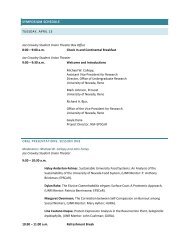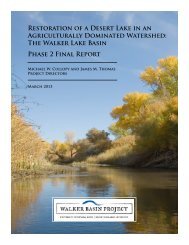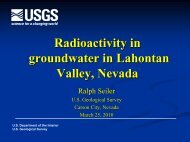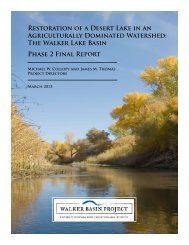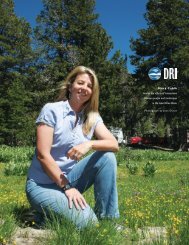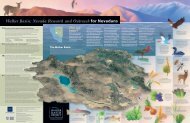Student Research Programs - Office of Undergraduate and ...
Student Research Programs - Office of Undergraduate and ...
Student Research Programs - Office of Undergraduate and ...
Create successful ePaper yourself
Turn your PDF publications into a flip-book with our unique Google optimized e-Paper software.
NUTRIENT CONCENTRATIONS IN O-HORIZON LEACHATE<br />
Rachel Funk<br />
Program: NSF REU<br />
Mentor: Wally Miller<br />
Major: Environmental Sciences<br />
Eureka College<br />
O Horizon leachate from Sierran forests can be an important contributor <strong>of</strong><br />
inorganic nutrients in soil, overl<strong>and</strong> <strong>and</strong>/or litter interflow, <strong>and</strong> water quality. The<br />
nutrient content <strong>and</strong> leachability from litter (Oi) <strong>and</strong> duff (Oe) materials is<br />
therefore important, as is the duration <strong>of</strong> extraction (leaching) event. The effect <strong>of</strong><br />
material <strong>and</strong> extraction time on leachate nutrient concentration <strong>and</strong> amount was<br />
investigated for three O horizon materials (Oi, Oe, <strong>and</strong> Oi+Oe) from seven sites<br />
across the Sierras. The extractions were performed over 4 extraction intervals (10<br />
min, 30 min, 60 min <strong>and</strong> 120 min) with 3 replications for a 3x4x3 study design. The results will show how<br />
nutrients are discharged from the o-horizon, including which layers serve as sources <strong>of</strong> nutrients <strong>and</strong> how<br />
concentrations are affected by extraction time.<br />
HYDROTHERMAL CARBONIZATION OF WOODY BIOMASS<br />
Brian Gallaspy<br />
Program: NSF EPSCoR<br />
Mentors: Kent Hoekman, Wei Yan<br />
Department: Chemical Engineering<br />
University <strong>of</strong> Nevada, Reno<br />
Hydrothermal carbonization (HTC) is a process by which lignocellulosic (woody)<br />
biomass is converted into a solid fuel having a higher energy density than the<br />
starting feedstock. Broadly, lignocellulosic biomass is composed <strong>of</strong> three<br />
components: cellulose, hemi-cellulose <strong>and</strong> lignin. The HTC reaction is carried out by<br />
placing the feedstock in hot, pressurized water. Under these conditions, the hemicellulose<br />
readily breaks down into simple sugars that are dissolved into the water.<br />
The recovered solid product has a higher C/O ratio, <strong>and</strong> thereby a higher energy<br />
density. Under optimal HTC conditions, the biochar product has similar properties to a low-rank coal. One<br />
implication <strong>of</strong> this is that the HTC process could be used to produce a renewable solid fuel that could replace or<br />
supplement coal in existing power plants with little to no modification <strong>of</strong> the equipment used. This project aims to<br />
investigate how the reaction conditions affect the product. The reaction is carried out in a specially designed twochamber<br />
reactor which allows the water to be heated to the desired reaction conditions in the lower chamber,<br />
while the biomass waits in the upper chamber. The purpose <strong>of</strong> the two-chamber reactor is to allow for fine<br />
control <strong>of</strong> temperature conditions. Once the desired temperature is reached, a valve is opened <strong>and</strong> the biomass<br />
falls into the water <strong>and</strong> the reaction begins. The conditions being varied are: temperature (200 °C, 230 °C <strong>and</strong> 260<br />
°C), reaction hold time (1, 3 <strong>and</strong> 5 minutes), <strong>and</strong> particle size (14-28 mesh, 10-14 mesh <strong>and</strong> 8-10 mesh). The<br />
product is then pelletized, <strong>and</strong> characterized using calorimetry along with a number <strong>of</strong> other physical tests<br />
including strength, attrition <strong>and</strong> hydrophobicity.<br />
10



